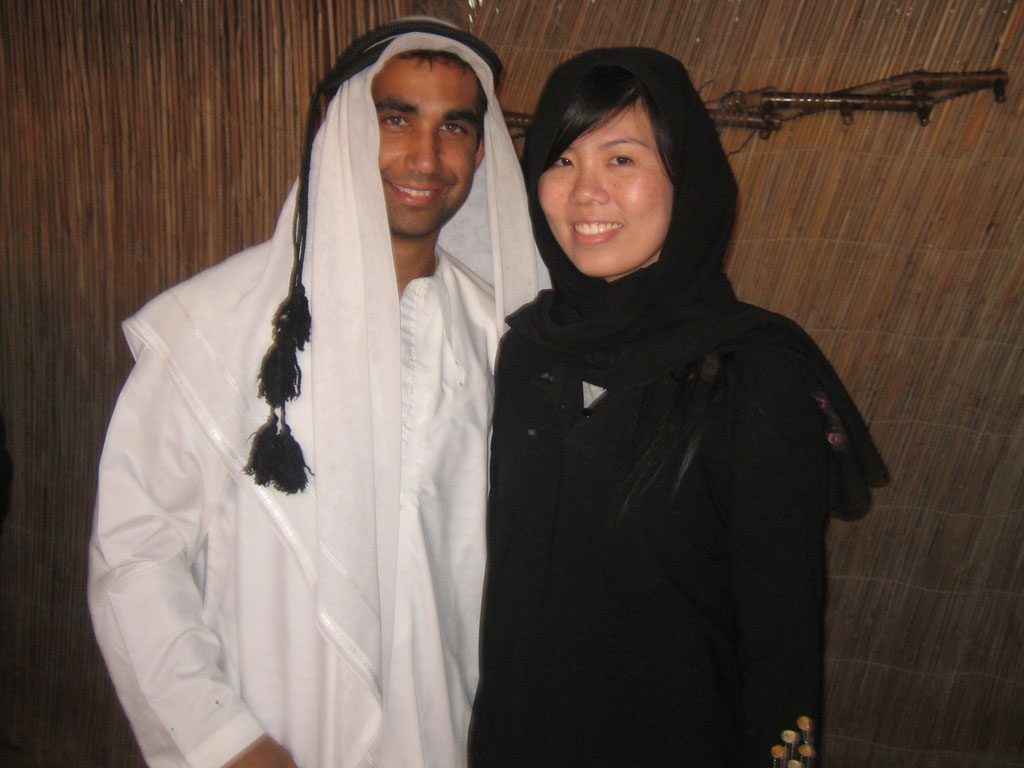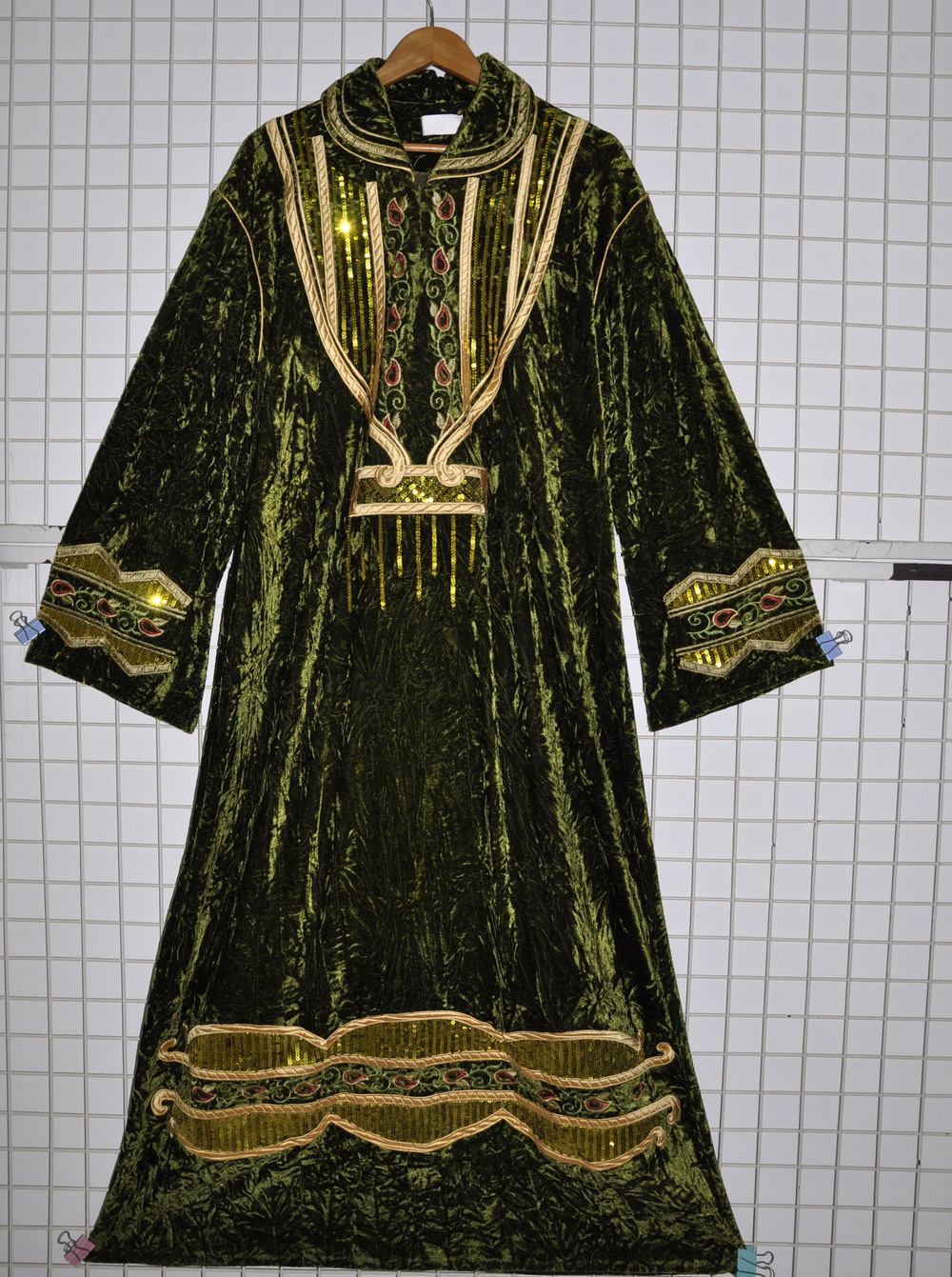About Arabic Clothes
Source (google.com.pk)
A niqab (Arabic: نِقاب niqāb , "veil" or "mask"; also called a ruband ) is a cloth which covers the face as a part of sartorial hijab. It is worn by some Muslim women in public areas and in front of non-mahram adult males. The niqab is worn in the Arab countries of the Arabian Peninsula such as Saudi Arabia, Yemen, Oman, and the UAE. The niqab is also worn in countries such as Somalia, Syria, Afghanistan, Pakistan, India, Bangladesh as well as some parts of Palestinian-ruled territories, southern provinces of Iran, and additional areas with sizeable Muslim populations. Because of the wide variety of hijab worn in the Muslim world, it can be difficult to definitively distinguish between one type of veil and another. The terms niqab and burqa are often incorrectly used interchangeably; a niqab covers the face while a burqa covers the whole body from the top of the head to the ground. The niqab is not forced by the quran it is considered as a choice for sunni islam and shia islam women. How ever the hijab is required to be worn by islamic law. The burqa "is required in afghanistan when leaving your house"
Etymology[edit]
Women who wear the niqab are often called niqābīah ; this word is used both as a noun and as an adjective. However, the correct form منتقبة muntaqabah / muntaqibah (plural muntaqabāt / muntaqibāt ) as niqābīah is used in a derogatory manner (much as with ḥijābīah versus محجبة muḥajjabah ).[2] Colloquially, women in niqab are called منقبة munaqqabah , with the plural منقبات munaqqabāt . The word niqabi is commonly used in English[by whom?] to refer to a woman who wears a niqab.
Overview[edit]
Pre-Islamic use of the face veil[edit]
It is sometimes alleged that the face-veil was originally part of women's dress among certain classes in the Byzantine Empire and was adopted into Muslim culture during the Arab conquest of the Middle East.[3] However, although Byzantine art before Islam commonly depicts women with veiled heads or covered hair, it does not depict women with veiled faces. In addition, the Greek geographer Strabo, writing in the first century AD, refers to some Persian women veiling their faces;[4][not in citation given] and the early third-century Christian writer Tertullian clearly refers in his treatise The Veiling of Virgins to some pagan women of "Arabia" wearing a veil that covers not only their head but also the entire face.[5] Clement of Alexandria commends the contemporary use of face coverings.[6][7] There are also two Biblical references to the employment of covering face veils in Genesis 38.14 and Genesis 24.65, by Tamar and by Rebekah, Jacob and Abraham's daughters-in-law respectively.[8][9][10] These primary sources show that some women in Egypt, Arabia, Canaan and Persia veiled their faces long before Islam. In the case of Tamar, the Biblical text,'When Judah saw her, he thought her to be an harlot; because she had covered her face' indicates customary, if not sacral, use of the face veil to accentuate rather than disguise her sexuality.[11]
Niqab in Islam[edit]
Views among Muslim scholars[edit]
There is a difference of opinion amongst scholars in Islam as to whether or not covering the face is obligatory (fard). The niqab has continued to arouse debate between Muslim scholars and jurists both past and present concerning whether it is fard (obligatory), mustahabb (recommended/preferable), or cultural.[12]
Sunni[edit]
The opinions of the four traditional Sunni schools of jurisprudence are as follows:
Maliki: In the Maliki madhhab, the face and the hands of a woman are not awrah; therefore covering the face is not obligatory. However, Maliki scholars have stated that it is highly recommended (mustahabb) for women to cover their faces.
Hanafi: The Hanafi school does not consider a woman's face to be awrah;however it is still obligatory (wajib) for a woman to cover her face. While the Hanafi school has not completely forbidden a male’s gaze towards a female’s face when there exists absolutely no fear of attraction, the woman has no way of knowing whether the gazes directed towards her are free of desire or not, especially when she is out in public. The Hanafi school has thus obliged women to cover their faces in front of strangers.[13][14]
Shafi'i: The Shafi'i school has had two well-known positions on this issue. The first view is that covering the face is obligatory at all times when in presence of non-mahram men.[15] The second view is that covering the face is preferred in general, but obligatory only in a time of fitnah (where men do not lower their gaze; or when a woman is very attractive)[16]
Hanbali: According to the Hanbali school, there are two differing views on whether a woman's whole body is awrah or not. Mālik, Awzāʿī, and Shafiʿī suggest that the awrah of a woman is her entire body excluding her face and her hands. Hence, covering the face would not be obligatory (fard) in this madhhab.[17] According to scholars like Tirmidhī and Ḥārith b. Hishām, however, all of a woman's body is awra, including her face, hands, and even fingernails. There is a dispensation though that allows a woman to expose her face and hands, e.g. when asking for her hand in marriage, because it is the centre of beauty.[18]
The modern Salafi movement (with the only exception of Muhammad Nasiruddin al-Albani) state that it is obligatory for a woman to cover her entire body when in public or in presence of non-mahram men.[19][20] Some interpretations say that a veil is not compulsory in front of blind, asexual or gay men.[21][22][23]
Shia, Sufism and other denominations[edit]
Salafi women in several countries, including Saudi Arabia, veil their faces because they believe the face of a woman is considered awrah. Wearing the niqab, however, is not exclusive to the Salafi movement and other Sunni Muslims may regard niqab either as obligatory or as mustahabb (recommended, an additional act of worship).[24][not in citation given][25][not in citation given] In the Shi'a Ja'fari school of fiqh, covering the face is not obligatory.
A niqab (Arabic: نِقاب niqāb , "veil" or "mask"; also called a ruband ) is a cloth which covers the face as a part of sartorial hijab. It is worn by some Muslim women in public areas and in front of non-mahram adult males. The niqab is worn in the Arab countries of the Arabian Peninsula such as Saudi Arabia, Yemen, Oman, and the UAE. The niqab is also worn in countries such as Somalia, Syria, Afghanistan, Pakistan, India, Bangladesh as well as some parts of Palestinian-ruled territories, southern provinces of Iran, and additional areas with sizeable Muslim populations. Because of the wide variety of hijab worn in the Muslim world, it can be difficult to definitively distinguish between one type of veil and another. The terms niqab and burqa are often incorrectly used interchangeably; a niqab covers the face while a burqa covers the whole body from the top of the head to the ground. The niqab is not forced by the quran it is considered as a choice for sunni islam and shia islam women. How ever the hijab is required to be worn by islamic law. The burqa "is required in afghanistan when leaving your house"
Etymology[edit]
Women who wear the niqab are often called niqābīah ; this word is used both as a noun and as an adjective. However, the correct form منتقبة muntaqabah / muntaqibah (plural muntaqabāt / muntaqibāt ) as niqābīah is used in a derogatory manner (much as with ḥijābīah versus محجبة muḥajjabah ).[2] Colloquially, women in niqab are called منقبة munaqqabah , with the plural منقبات munaqqabāt . The word niqabi is commonly used in English[by whom?] to refer to a woman who wears a niqab.
Overview[edit]
Pre-Islamic use of the face veil[edit]
It is sometimes alleged that the face-veil was originally part of women's dress among certain classes in the Byzantine Empire and was adopted into Muslim culture during the Arab conquest of the Middle East.[3] However, although Byzantine art before Islam commonly depicts women with veiled heads or covered hair, it does not depict women with veiled faces. In addition, the Greek geographer Strabo, writing in the first century AD, refers to some Persian women veiling their faces;[4][not in citation given] and the early third-century Christian writer Tertullian clearly refers in his treatise The Veiling of Virgins to some pagan women of "Arabia" wearing a veil that covers not only their head but also the entire face.[5] Clement of Alexandria commends the contemporary use of face coverings.[6][7] There are also two Biblical references to the employment of covering face veils in Genesis 38.14 and Genesis 24.65, by Tamar and by Rebekah, Jacob and Abraham's daughters-in-law respectively.[8][9][10] These primary sources show that some women in Egypt, Arabia, Canaan and Persia veiled their faces long before Islam. In the case of Tamar, the Biblical text,'When Judah saw her, he thought her to be an harlot; because she had covered her face' indicates customary, if not sacral, use of the face veil to accentuate rather than disguise her sexuality.[11]
Niqab in Islam[edit]
Views among Muslim scholars[edit]
There is a difference of opinion amongst scholars in Islam as to whether or not covering the face is obligatory (fard). The niqab has continued to arouse debate between Muslim scholars and jurists both past and present concerning whether it is fard (obligatory), mustahabb (recommended/preferable), or cultural.[12]
Sunni[edit]
The opinions of the four traditional Sunni schools of jurisprudence are as follows:
Maliki: In the Maliki madhhab, the face and the hands of a woman are not awrah; therefore covering the face is not obligatory. However, Maliki scholars have stated that it is highly recommended (mustahabb) for women to cover their faces.
Hanafi: The Hanafi school does not consider a woman's face to be awrah;however it is still obligatory (wajib) for a woman to cover her face. While the Hanafi school has not completely forbidden a male’s gaze towards a female’s face when there exists absolutely no fear of attraction, the woman has no way of knowing whether the gazes directed towards her are free of desire or not, especially when she is out in public. The Hanafi school has thus obliged women to cover their faces in front of strangers.[13][14]
Shafi'i: The Shafi'i school has had two well-known positions on this issue. The first view is that covering the face is obligatory at all times when in presence of non-mahram men.[15] The second view is that covering the face is preferred in general, but obligatory only in a time of fitnah (where men do not lower their gaze; or when a woman is very attractive)[16]
Hanbali: According to the Hanbali school, there are two differing views on whether a woman's whole body is awrah or not. Mālik, Awzāʿī, and Shafiʿī suggest that the awrah of a woman is her entire body excluding her face and her hands. Hence, covering the face would not be obligatory (fard) in this madhhab.[17] According to scholars like Tirmidhī and Ḥārith b. Hishām, however, all of a woman's body is awra, including her face, hands, and even fingernails. There is a dispensation though that allows a woman to expose her face and hands, e.g. when asking for her hand in marriage, because it is the centre of beauty.[18]
The modern Salafi movement (with the only exception of Muhammad Nasiruddin al-Albani) state that it is obligatory for a woman to cover her entire body when in public or in presence of non-mahram men.[19][20] Some interpretations say that a veil is not compulsory in front of blind, asexual or gay men.[21][22][23]
Shia, Sufism and other denominations[edit]
Salafi women in several countries, including Saudi Arabia, veil their faces because they believe the face of a woman is considered awrah. Wearing the niqab, however, is not exclusive to the Salafi movement and other Sunni Muslims may regard niqab either as obligatory or as mustahabb (recommended, an additional act of worship).[24][not in citation given][25][not in citation given] In the Shi'a Ja'fari school of fiqh, covering the face is not obligatory.
Arabic Clothes Abaya Designs 2014 Dress Collection Dubai Styles Fashion Pics Photos Images Wallpapers

Arabic Clothes Abaya Designs 2014 Dress Collection Dubai Styles Fashion Pics Photos Images Wallpapers

Arabic Clothes Abaya Designs 2014 Dress Collection Dubai Styles Fashion Pics Photos Images Wallpapers

Arabic Clothes Abaya Designs 2014 Dress Collection Dubai Styles Fashion Pics Photos Images Wallpapers

Arabic Clothes Abaya Designs 2014 Dress Collection Dubai Styles Fashion Pics Photos Images Wallpapers

Arabic Clothes Abaya Designs 2014 Dress Collection Dubai Styles Fashion Pics Photos Images Wallpapers

Arabic Clothes Abaya Designs 2014 Dress Collection Dubai Styles Fashion Pics Photos Images Wallpapers

Arabic Clothes Abaya Designs 2014 Dress Collection Dubai Styles Fashion Pics Photos Images Wallpapers

Arabic Clothes Abaya Designs 2014 Dress Collection Dubai Styles Fashion Pics Photos Images Wallpapers

Arabic Clothes Abaya Designs 2014 Dress Collection Dubai Styles Fashion Pics Photos Images Wallpapers

Arabic Clothes Abaya Designs 2014 Dress Collection Dubai Styles Fashion Pics Photos Images Wallpapers

Arabic Clothes Abaya Designs 2014 Dress Collection Dubai Styles Fashion Pics Photos Images Wallpapers

Arabic Clothes Abaya Designs 2014 Dress Collection Dubai Styles Fashion Pics Photos Images Wallpapers

Arabic Clothes Abaya Designs 2014 Dress Collection Dubai Styles Fashion Pics Photos Images Wallpapers

Arabic Clothes Abaya Designs 2014 Dress Collection Dubai Styles Fashion Pics Photos Images Wallpapers

Arabic Clothes Abaya Designs 2014 Dress Collection Dubai Styles Fashion Pics Photos Images Wallpapers

Arabic Clothes Abaya Designs 2014 Dress Collection Dubai Styles Fashion Pics Photos Images Wallpapers

Arabic Clothes Abaya Designs 2014 Dress Collection Dubai Styles Fashion Pics Photos Images Wallpapers

Arabic Clothes Abaya Designs 2014 Dress Collection Dubai Styles Fashion Pics Photos Images Wallpapers

Arabic Clothes Abaya Designs 2014 Dress Collection Dubai Styles Fashion Pics Photos Images Wallpapers

Arabic Clothes Abaya Designs 2014 Dress Collection Dubai Styles Fashion Pics Photos Images Wallpapers

Arabic Clothes Abaya Designs 2014 Dress Collection Dubai Styles Fashion Pics Photos Images Wallpapers

No comments:
Post a Comment